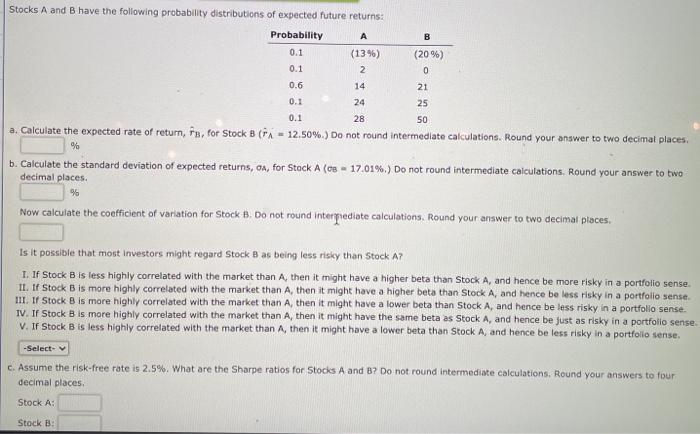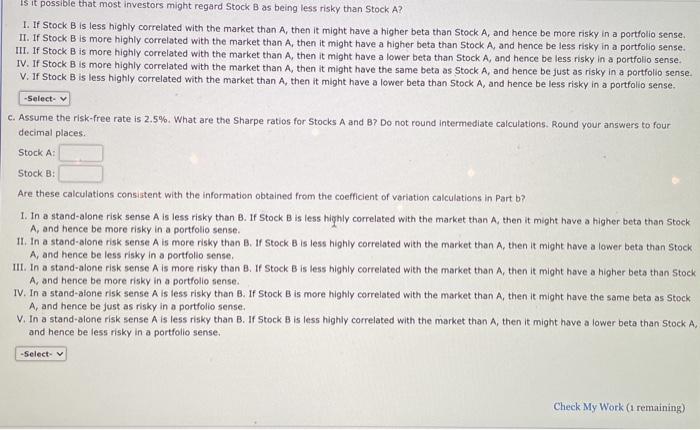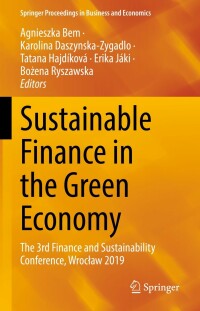B 0.1 Stocks A and B have the following probability distributions of expected future returns Probability A 0.1 (13%) (20%) 2. 0 0.6 14 21 0.1 24 25 0.1 28 50 a. Calculate the expected rate of return, fs, for Stock B ( = 12.50%.) Do not round Intermediate calculations. Round your answer to two decimal places % b. Calculate the standard deviation of expected returns, GA, for Stock A (os - 17.01%.) Do not round intermediate calculations. Round your answer to two decimal places. % Now calculate the coefficient of variation for Stock B. Do not round interprediate calculations. Round your answer to two decimal places. Is it possible that most investors might regard Stock B as being less risky than Stock A? 1. If Stock B is less highly correlated with the market than A, then it might have a higher beta than Stock A, and hence be more risky in a portfolio sense 11. If Stock B is more highly correlated with the market than A, then it might have a higher beta than Stock A, and hence be less risky in a portfolio sense. III. If Stock B is more highly correlated with the market than A, then it might have a lower beta than Stock A, and hence be less risky in a portfolio sense. IV. If Stock B is more highly correlated with the market than A, then it might have the same beta as Stock A, and hence be just as risky in a portfolio sense V. If Stock B is less highly correlated with the market than A, then it might have a lower beta than Stock A, and hence be less risky in a portfolio sense. -Select- c. Assume the risk-free rate is 2.5%. What are the Sharpe ratios for Stocks A and B? Do not round Intermediate calculations, Round your answers to four decimal places Stock A: Stock B : Is it possible that most investors might regard Stock B as being less risky than Stock A? 1. If Stock B is less highly correlated with the market than A, then it might have a higher beta than Stock A, and hence be more risky in a portfolio sense. II. If Stock B is more highly correlated with the market than A, then it might have a higher beta than Stock A, and hence be less risky in a portfolio sense. III. If Stock B is more highly correlated with the market than A, then it might have a lower beta than Stock A, and hence be less risky in a portfolio sense. IV. If Stock B is more highly correlated with the market than A, then it might have the same beta as Stock A, and hence be just as risky in a portfolio sense. V. If Stock B is less highly correlated with the market than A, then it might have a lower beta than Stock A, and hence be less risky in a portfolio sense. -Select- c. Assume the risk-free rate is 2.5%. What are the Sharpe ratios for Stocks A and B? Do not round Intermediate calculations. Round your answers to four decimal places. Stock A: Stock B: Are these calculations consistent with the information obtained from the coefficient of variation calculations in Part b? 1. In a stand-alone risk sense A is less risky than B. If Stock B is less highly correlated with the market than A, then it might have a higher beta than Stock A, and hence be more risky in a portfolio sense. 11. In a stand-alone risk sense A is more risky than B. If Stock B is less highly correlated with the market thon A, then it might have a lower beta than Stock A, and hence be less risky in a portfolio sense. III. In a stand-alone risk sense A is more risky than 3. If Stock B is less highly correlated with the market than A, then it might have a higher beta than Stock A, and hence be more risky in a portfolio sense. IV. In a stand-alone risk sense A is less risky than B. If Stock B is more highly correlated with the market than A, then it might have the same beta as Stock A, and hence be just as risky in a portfolio sense. V. In a stand-alone risk sense A is less risky than B. If Stock B is less highly correlated with the market than A, then it might have a lower beta than Stock A, and hence be less risky in a portfolio sense. -Select- Check My Work (1 remaining)








